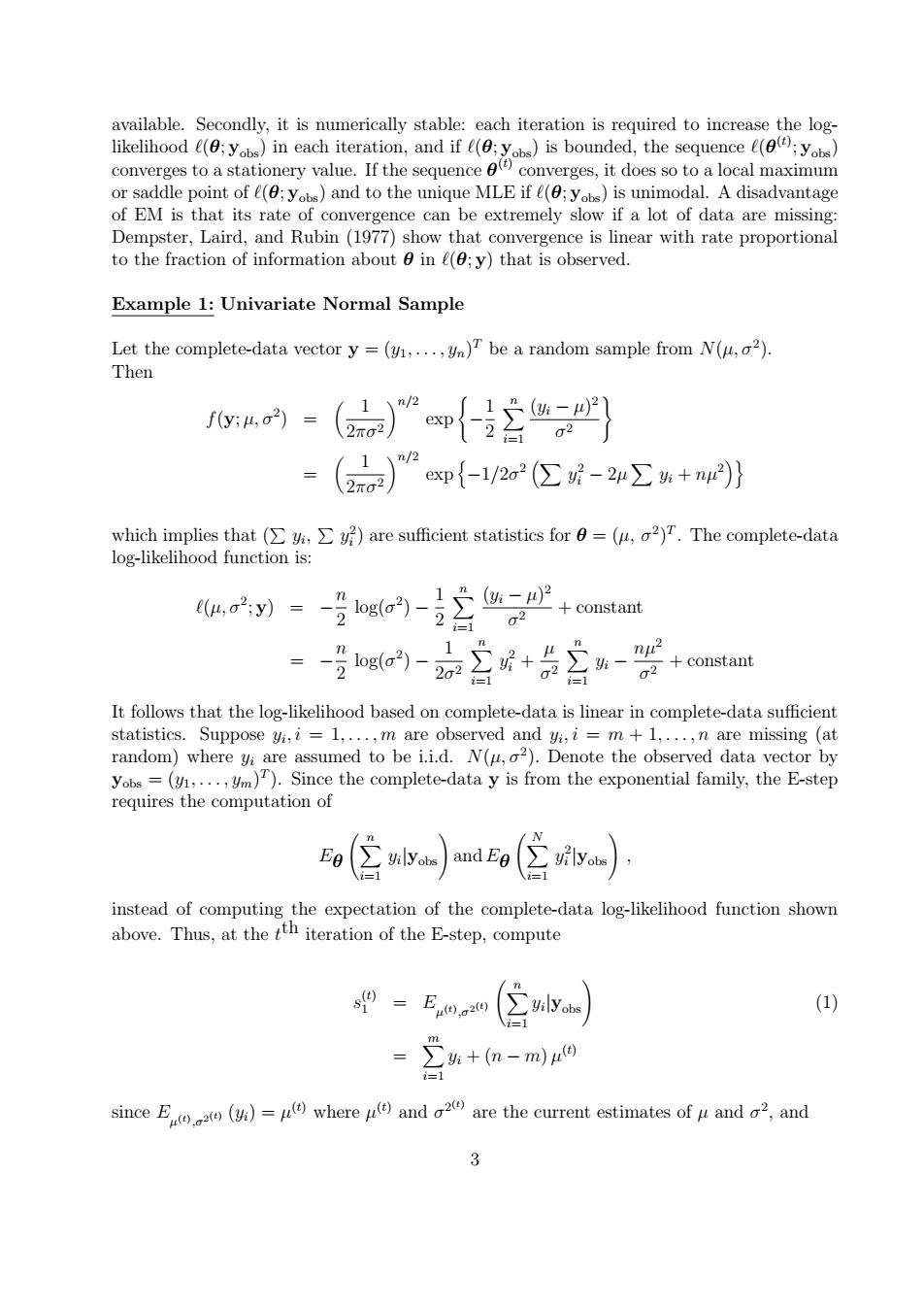正在加载图片...

available.Secondly,it is numerically stable:each iteration is required to increase the log- likelihood (:yb)in each iteration,and if (ys)is bounded,the sequence(y) converges to a stationery value.If the sequenceconverges,it does so to a local maximum or saddle point of e(;yobs)and to the unique MLE if e(e;yobs)is unimodal.A disadvantage of EM is that its rate of convergence can be extremely slow if a lot of data are missing: Dempster,Laird,and Rubin (1977)show that convergence is linear with rate proportional to the fraction of information about 0 in e(0;y)that is observed. Example 1:Univariate Normal Sample Let the complete-data vector y=(v,...,)T be a random sample from N(u,o2). Then f(y4,σ2)= 02 11n/2 xp{-1/2a2(∑听-2μ∑h+nr2)} which implies that (>yi,>y2)are sufficient statistics for =(u,o2)T.The complete-data log-likelihood function is: ,2y=-31ogo2)-32s9 i=1 02 constant 2 nu? =1 1=1 It follows that the log-likelihood based on complete-data is linear in complete-data sufficient statistics.Suppose yi,i=1,...,m are observed and yi,i =m+1,...,n are missing (at random)where yi are assumed to be i.i.d.N(u,o2).Denote the observed data vector by yobs=(,...,m)T).Since the complete-data y is from the exponential family,the E-step requires the computation of instead of computing the expectation of the complete-data log-likelihood function shown above.Thus,at the tth iteration of the E-step,compute s=E) (1) ∑+(n-m)μ =1 since E()=where and are the current estimates of uand 2 and 3available. Secondly, it is numerically stable: each iteration is required to increase the loglikelihood `(θ; yobs) in each iteration, and if `(θ; yobs) is bounded, the sequence `(θ (t) ; yobs) converges to a stationery value. If the sequence θ (t) converges, it does so to a local maximum or saddle point of `(θ; yobs) and to the unique MLE if `(θ; yobs) is unimodal. A disadvantage of EM is that its rate of convergence can be extremely slow if a lot of data are missing: Dempster, Laird, and Rubin (1977) show that convergence is linear with rate proportional to the fraction of information about θ in `(θ; y) that is observed. Example 1: Univariate Normal Sample Let the complete-data vector y = (y1, . . . , yn) T be a random sample from N(µ, σ 2 ). Then f(y; µ, σ 2 ) = 1 2πσ 2 n/2 exp ( − 1 2 Xn i=1 (yi − µ) 2 σ 2 ) = 1 2πσ 2 n/2 exp n −1/2σ 2 X y 2 i − 2µ X yi + nµ2 o which implies that ( P yi , P y 2 i ) are sufficient statistics for θ = (µ, σ 2 ) T . The complete-data log-likelihood function is: `(µ, σ 2 ; y) = − n 2 log(σ 2 ) − 1 2 Xn i=1 (yi − µ) 2 σ 2 + constant = − n 2 log(σ 2 ) − 1 2σ 2 Xn i=1 y 2 i + µ σ 2 Xn i=1 yi − nµ2 σ 2 + constant It follows that the log-likelihood based on complete-data is linear in complete-data sufficient statistics. Suppose yi ,i = 1, . . . , m are observed and yi ,i = m + 1, . . . , n are missing (at random) where yi are assumed to be i.i.d. N(µ, σ 2 ). Denote the observed data vector by yobs = (y1, . . . , ym) T ). Since the complete-data y is from the exponential family, the E-step requires the computation of Eθ Xn i=1 yi |yobs! and Eθ X N i=1 y 2 i |yobs! , instead of computing the expectation of the complete-data log-likelihood function shown above. Thus, at the t th iteration of the E-step, compute s (t) 1 = E µ(t) ,σ2 (t) Xn i=1 yi |yobs! (1) = Xm i=1 yi + (n − m) µ (t) since E µ(t) ,σ2 (t) (yi) = µ (t) where µ (t) and σ 2 (t) are the current estimates of µ and σ 2 , and 3